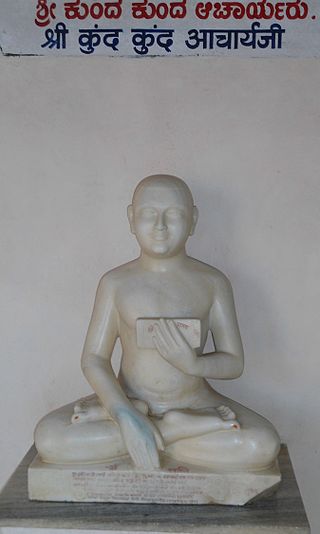
Hemachandra was a 12th century Indian Jain saint, scholar, poet, mathematician, philosopher, yogi, grammarian, law theorist, historian, lexicographer, rhetorician, logician, and prosodist. Noted as a prodigy by his contemporaries, he gained the title kalikālasarvajña, "the knower of all knowledge in his times" and father of the Gujarati language.

Ācārya Bhadrabāhu was, according to the Digambara sect of Jainism, the last Shruta Kevalin in Jainism. He was the last acharya of the undivided Jain sangha. He was the spiritual teacher of Chandragupta Maurya, the founder of the Maurya Empire.

Acharya Shri Vidyasagarji Maharaj was an Indian Digambara Jain Acharya. He was recognized both for his scholarship and tapasya (austerity). He was known for his long hours in meditation. While he was born in Karnataka and took diksha in Rajasthan, he generally spent much of his time in the Bundelkhand region where he is credited with having brought about a revival in educational and religious activities. He wrote the epic Hindi poem "Mukamati".

Acharya Shri Shantisagar Ji (1872–1955) was an Indian monk of the Digambar Jain faith. He was the first Acharya (preceptor) and a leader of his sect in the 20th century. Shanti Sagar ji revived the teaching and practice of traditional Digambara practices in North India. He was lustrated as a kshullaka into the Sangha by Devappa (Devakirti) Swami Ji. He took his ailaka deeksha before an image of the Tirthankara Neminatha. In about 1920, Shantisagar Ji became a full muni (monk) of the Digambara sect of Jainism. In 1922, at Yarnal village, Belgaum district, Karnataka, he was given the name "Shanti Sagar Ji".
Tapa Gaccha is the largest Gaccha of Svetambara Jainism.

Acharya Pujyapada or Pūjyapāda was a renowned grammarian and acharya belonging to the Digambara tradition of Jains. It was believed that he was worshiped by demigods on the account of his vast scholarship and deep piety, and thus, he was named Pujyapada. He was said to be the guru of King Durvinita of the Western Ganga dynasty.
Jainism is a religion founded in ancient India. Jains trace their history through twenty-four tirthankara and revere Rishabhanatha as the first tirthankara. The last two tirthankara, the 23rd tirthankara Parshvanatha and the 24th tirthankara Mahavira are considered historical figures. According to Jain texts, the 22nd tirthankara Neminatha lived about 5,000 years ago and was the cousin of Krishna.
Jainism is an ancient Indian religion belonging to the śramaṇa tradition. It prescribes ahimsa (non-violence) towards all living beings to the greatest possible extent. The three main teachings of Jainism are ahimsa, anekantavada (non-absolutism), aparigraha (non-possessiveness). Followers of Jainism take five main vows: ahimsa, satya, asteya, brahmacharya (chastity), and aparigraha. Monks follow them completely whereas śrāvakas (householders) observe them partially. Self-discipline and asceticism are thus major focuses of Jainism.
Ramchandrasuri was a Jain monk and scholar.

Acharya Vijay Vallabhsuri was a Jain monk. He was a disciple of Vijayanandsuri. He worked in Punjab so he was given honorific Punjab Kesari.
Hiravijaya (1526–1595), also known as Muni Hiravijayji and Hiravijay Suri, was a high priest of the Tapa Gaccha monastic order, following the Jain Svetambara tradition. He is known for propounding the Jain philosophy to Mughal Emperor Akbar and turning him towards vegetarianism.

Digambara is one of the two major schools of Jainism, the other being Śvetāmbara (white-clad). The Sanskrit word Digambara means "sky-clad", referring to their traditional monastic practice of neither possessing nor wearing any clothes.

Jainism is an Indian religion which is traditionally believed to be propagated by twenty-four spiritual teachers known as tirthankara. Broadly, Jainism is divided into two major schools of thought, Digambara and Śvetāmbara. These are further divided into different sub-sects and traditions. While there are differences in practices, the core philosophy and main principles of each sect is the same.

Panyas Chandrashekhar Vijayji Maharaj Saheb, also known as Gurudev or Guruma, was a Jain monk, scholar and author. Born and educated in Mumbai, he was initiated as a monk who was later designated Panyas. He was involved in religious as well as sociopolitical activities. He founded several institutions and authored 261 books.
Acharya Guptinandi Ji is a Digambara monk initiated by Acharya Kunthusagar.

Acharya Ravisena was a seventh century Digambara Jain Acharya, who wrote Padmapurana in Sanskrit in 678 AD. In Padmapurana, he mentions about a ceremony called suttakantha, which means the thread hanging from neck.

Samantabhadra was a Digambara acharya who lived about the later part of the second century CE. He was a proponent of the Jaina doctrine of Anekantavada. The Ratnakaranda śrāvakācāra is the most popular work of Samantabhadra. Samantabhadra lived after Umaswami but before Pujyapada.

Muni Mohjit Vijayji(14 October 1944 – 2 September 2000) born as Mahendra Kumar Mota,, Jain ascetic of Swetamber tradition was a disciple of Acharya Ramchandrasuri and was initiated in monkhood on 29 April 1979 along with his younger brother Navinkumar. Both brothers are widely known as 'Mota Pandit Maharaj Saheb' and 'Nana Pandit Maharaj Saheb' respectively in view of their expertise in Jain scriptures.

Yugbhushan Suri(born 26 October 1957) born as Naveen Khimji Mota is a Jain acharya of Shwetamber tradition.
"Sambharana suri prem na" book published in vs 2039.











